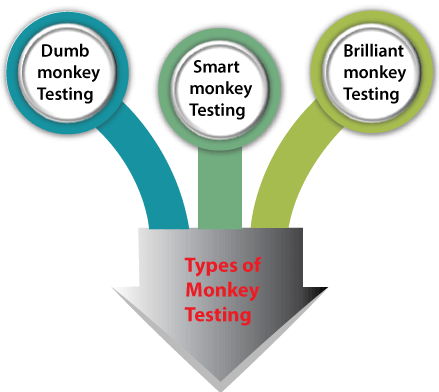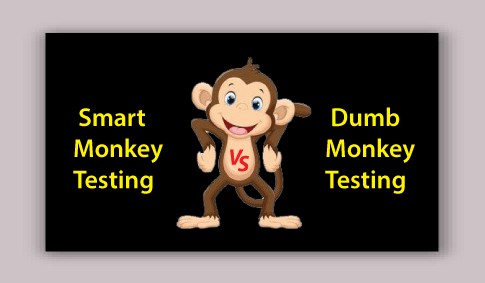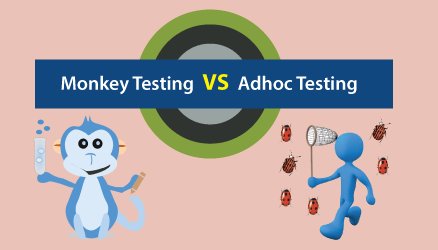Monkey TestingIn Software Development Life Cycle (SDLC), the testing phase plays a crucial role in order to help test engineers to establish the quality, performance, consistency, efficiency, and security of the product, together before and after its release. As we know that the testing process is the best way to identify the bugs and defects in the particular software and control them immediately, they are detected by the team of test engineers. In this tutorial, we are going to understand the following topic of the particular type of software testing, namely Monkey testing.
Introduction to Monkey TestingOne of the unique types of software testing is Monkey Testing. It was firstly introduced in the book The Art of Software Testing which is written by Glenford J. Myers in 1979. It is a software testing technique where the user checks the application by giving random inputs; that's why it is also known as Random testing. If we don't have enough time to write and perform the tests, we will implement the monkey testing. It is also known as stochastic testing, and best suited for desktop, web, as well as mobile applications. It is a time and effort-saving process if we are using random testing or monkey testing inputs. Monkey testing is usually executed as random, automated unit tests, and provides us the benefits of efficiently assessing software reliability from test results. The monkey testing is primarily implemented automatically where the user inserts any random invalid input and tests its performance. If we are performing load and stress testing, Monkey testing works very well, or we can it is a very good approach. The data created or developed from random testing can be additionally used to approximate product consistency. On the other hand, various testing approaches cannot be used in this way to approximate the software consistency. It is trendy among test engineers as they used this testing to test applications by providing random inputs and checking their behavior. To detect the bugs and errors in the software application by using tentative performances is the primary intent of executing the monkey testing. Features of Monkey TestingSubsequently, Monkey Testing includes testing the software or application by giving some random data and detecting whether the system fails or not. The key intent of executing the monkey testing is to identify the defects and errors in the software and make sure that the system does not crash once the entire development on the software product is done. Some of the significant features of monkey testing or random testing are as follows:
Usage of Monkey Testing
Types of Monkey TestingAccording to its way of execution, Monkey Testing is divided into various types. To get a quick idea of it we can see in the below images: 
Now, let us see them one by one for our better understanding: Dumb Monkey TestingThe first type of monkey testing is Dumb Monkey testing. It is the easiest and direct type of monkey testing that does not know their or system's abilities or the application's flow. In this testing, we can identify fewer bugs than the smart monkeys but can naively discover significant bugs that are hard to find. In this, the test Manager or lead appoints a test engineer who does not have the knowledge of particular module of an application in order test the product. Even those test engineers do not have any idea whether the given inputs are valid or invalid. That is why dumb monkey testing is also known as Ignorant monkeys. In other words, we can say that the dumb monkey does not aware of the work flow or data being sustained to the application or the system. The test engineer is asked to test the application automatically and enter random data where the test engineer feels suitable. The following features can acknowledge a dumb monkey:
Smart Monkey TestingThe next type of monkey testing is Smart Monkey testing, wherein the test engineer is entirely attentive of the system or the application. Additionally, the testing team knows the functionality of the exact product and consequently gives inputs, which are suitable and valid that helps to execute tests on the product. Furthermore, the smart monkey tests are aware of where the pages of the application will redirect to. In smart monkey testing, the test engineer is focused on surpassing the application, and if they identify an error, they are smart enough to report a bug. Also, smart testing is an excellent choice to perform load testing and stress testing. In other words, we can say that the test engineer has a piece of specific knowledge about the system, its objective, and functionality, and the test engineer navigates through the system and provides valid inputs in order to execute the testing. Brilliant Monkey TestingThe last and third type of monkey testing is brilliant monkey testing. In this type of monkey testing, the test engineer has a good knowledge of the system. This type of testing can also identify some bugs, which might be found in the software in the future. Furthermore, the test engineer knows about the pattern of using the product, and henceforth, they can perform testing from the user's viewpoint. In other words, we can say that brilliant monkey testing is one step ahead of smart monkey testing. In this, the test engineer or a team of test engineers is assigned for the task, as they have complete knowledge about the particular software domain and its features. Difference between Smart Monkey Testing and Dumb Monkey TestingLet us see some significant comparisons between Smart Monkey Testing and Dumb Monkey Testing in the below table. 
Is Monkey Testing being similar as Gorilla Testing and Fuzz Testing?
Note: Some people find monkey and Adhoc testing as a similar type of testing technique, which is incorrect because ad-hoc testing is performed without any planning or documentation work.To clarify the above statement, we can the difference between monkey and Adhoc testing. Monkey Testing vs Adhoc TestingLet see some significant difference between monkey testing and Adhoc testing in the below table: 
Benefits and Drawbacks of Monkey TestingIt is a software testing procedure that analysis the test scenarios, which are random and Adhoc. Despite giving various benefits to the end-users and test engineers, monkey testing has numerous drawbacks, which can suppress its positive abilities. Hence, there are some of the essential advantages along with the disadvantages of monkey testing are as discussed below: Advantages of Monkey TestingFollowing are some of the significant benefits of monkey testing:
Disadvantages of Monkey TestingFollowing are the drawbacks of Monkey testing:
OverviewIn this tutorial, we have learned that Monkey Testing is a type of software testing that is relatively new and popular among software test engineers and very beneficial in some testing areas. Monkey testing is knowingly different from Gorilla testing and Adhoc Testing. Monkey testing is divided into three types of testing is Dumb monkey testing, Smart monkey testing, and Brilliant Monkey testing. In Monkey testing, the users entering the random inputs and then implementing the testing to check its performance and to know whether the system or application fails or not. Furthermore, monkey testing is an automated test conducted by a team of test engineers without any detailed test in mind. And at last, we can say that Monkey testing is the easiest way of checking the quality of software features and the performance of the software; because of this quality, monkey testing is also known as random testing.
Next TopicAgile Testing
|
 For Videos Join Our Youtube Channel: Join Now
For Videos Join Our Youtube Channel: Join Now
Feedback
- Send your Feedback to [email protected]
Help Others, Please Share









